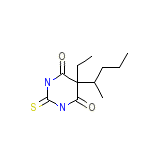Intraval




Intraval Brand names, Intraval Analogs
Intraval Brand Names Mixture
- Thiotal 5g (Thiopental Sodium + Water)
Intraval Chemical_Formula
C11H18N2O2S
Intraval RX_link
http://www.rxlist.com/cgi/generic3/thiopental.htm
Intraval fda sheet
Intraval msds (material safety sheet)
Intraval Synthesis Reference
No information avaliable
Intraval Molecular Weight
242.339 g/mol
Intraval Melting Point
No information avaliable
Intraval H2O Solubility
No information avaliable
Intraval State
Solid
Intraval LogP
2.321
Intraval Dosage Forms
Powder for solution
Intraval Indication
For use as the sole anesthetic agent for brief (15 minute) procedures, for induction of anesthesia prior to administration of other anesthetic agents, to supplement regional anesthesia, to provide hypnosis during balanced anesthesia with other agents for analgesia or muscle relaxation, for the control of convulsive states during or following inhalation anesthesia or local anesthesia, in neurosurgical patients with increased intracranial pressure, and for narcoanalysis and narcosynthesis in psychiatric disorders.
Intraval Pharmacology
Thiopental, a barbiturate, is used for the induction of anesthesia prior to the use of other general anesthetic agents and for induction of anesthesia for short surgical, diagnostic, or therapeutic procedures associated with minimal painful stimuli. Thiopental is an ultrashort-acting depressant of the central nervous system which induces hypnosis and anesthesia, but not analgesia. It produces hypnosis within 30 to 40 seconds of intravenous injection. Recovery after a small dose is rapid, with some somnolence and retrograde amnesia. Repeated intravenous doses lead to prolonged anesthesia because fatty tissues act as a reservoir; they accumulate Pentothal in concentrations 6 to 12 times greater than the plasma concentration, and then release the drug slowly to cause prolonged anesthesia
Intraval Absorption
Rapidly absorbed.
Intraval side effects and Toxicity
Overdosage may occur from too rapid or repeated injections. Too rapid injection may be followed by an alarming fall in blood pressure even to shock levels. Apnea, occasional laryngospasm, coughing and other respiratory difficulties with excessive or too rapid injections may occur. Lethal blood levels may be as low as 1 mg/100 mL for short-acting barbiturates; less if other depressant drugs or alcohol are also present.
Intraval Patient Information
When appropriate, patients should be instructed as to the hazards of drowsiness that may follow use of barbiturates. Outpatients should be released in the company of another individual, and no skilled activities, such as operating machinery or driving a motor vehicle, should be engaged in for 8 to 12 hours.
Intraval Organisms Affected
Humans and other mammals














